In event and experiential marketing, audience segmentation involves dividing a broad market into smaller, meaningful groups based on shared characteristics.
These characteristics can include demographics, behaviors, psychographics, geography, or other factors that are directly related to the value of a specific customer or prospect for your organization.
Segmentation helps event marketers tailor their strategies to meet the specific needs of each group, so their campaigns are more relevant, efficient and impactful.
As Ev&Ex’s John Capano explains, that’s crucial:
“Audience segmentation is enormously important for events and experiences. When you’re asking people to invest a fair amount of time and attention to your brand, the better you understand their needs, the better you can deliver value.”
What are some of the methods and components involved?
Levels of Application
- Sub-Groups Within a Market:
- Define the relative value of each subgroup in terms of revenue potential, customer lifetime value, and market trends. This allows companies to allocate resources more effectively to segments that promise the highest returns.
- Develop tailored strategies to address the unique characteristics and expectations of each subgroup. For instance, premium products may want to host events at upscale locales where the ideal audience is most comfortable with such experiences.
- Target Audience Grouping:
- Break down the larger audience into manageable and specific segments to deliver focused and relevant communications that resonate with their preferences.
- Design engagement tactics that align with each segment’s consumption habits, lifestyle, and expectations. For example, younger audiences may prefer social media campaigns as part of a pre-promotion strategy for your event, while older demographics might respond better to email marketing.
Core Components of Segmentation Studies
1. Total Market Size:
- Understand the overall size and scope of the market to determine the potential reach and scale of your efforts. Quantify the total number of potential customers so you can plan your event calendar appropriately.
- Assess historical attendance patterns, current event trends, and projected future developments to gain a comprehensive view of the event landscape. This insight helps in identifying emerging opportunities and areas of decline, enabling marketers to optimize their planning.
2. Segmentation Criteria:
- Identify the specific factors—such as age, behavior, and location—that will be used to create distinct segments.
- Ensure these criteria reflect the unique challenges and opportunities within the market to ensure the segmentation provides actionable insights that drive event design.
3. Segment Profiles/Personas:
- Develop in-depth profiles for each segment, highlighting shared characteristics, needs, and behaviors to better target and engage them. Include motivations, pain points, and decision-making processes.
- Include visual and narrative elements to make the profiles relatable and actionable for team members. For instance, create detailed personas that reflect real-world behaviors and preferences.
4. Perceptual Map:
- Use data visualization to display market gaps, opportunities, and unmet needs across different audience segments for events. For instance, plot attendee satisfaction against event design elements to understand what event features drive greater engagement and satisfaction.
- Highlight areas where competitors are over- or under-represented to identify strategic positioning opportunities for your event, ensuring your program stands out.
Audience segmentation should consist of individuals or entities with shared characteristics, ensuring that each group has similar needs or behaviors. It can be a standalone effort or part of a larger event marketing strategy.
Ready to apply segmentation to your event marketing initiatives? Great! But if you need help getting the most out of this practice, you can turn to the pros who have helped enterprises deliver honed segmentation strategies for marketers just like you: Contact Ev&Ex today!


